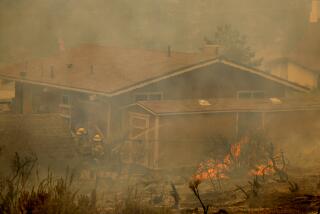Dust to Ashes: Soil Falls Victim to Forest Fire
One of the casualties of the Williams fire that swept through the Angeles National Forest was a small, pyramid-shaped shed that might be easy to ignore on the list of 62 homes and 14 outbuildings destroyed.
But the underground shed housed strange yet precious cargo: Nearly 1,000 jars filled with dirt collected 67 years ago, a living archive of sorts that in recent years had been a gold mine for soil scientists.
Scientists were surprised to learn that a thin layer of clay particles within soil, called an argillic horizon, takes decades, rather than centuries, to form. With the jars, they had been able to study how pollution affects soil composition. Lead and zinc released into the air, they realized, quickly make their way into the ground.
But when the fire raced through the forest, the collection was lost.
The jars of soil were the byproduct of another sort of scientific experiment, one that concluded long ago. In 1935, scientists working within the San Dimas Experimental Forest, a portion of the larger Angeles National Forest set aside to conduct scientific research, were interested in learning how they might manipulate forest vegetation to yield more water for the people who lived nearby. So they built a series of lysimeters--complicated, overgrown planters--in a vast clearing of the experimental forest to measure how plants took in and processed water.
The project, built with the help of the Civilian Conservation Corps, was so elaborate and labor-intensive that it probably never would be duplicated today. Thirty-two lysimeters, most of them 11 feet wide, 21 feet long and 6 feet deep, were planted with five kinds of native vegetation: scrub oak, Coulter pine, buckwheat and the evergreen shrubs chamise and ceanothus.
An underground concrete bunker housed a system of water tanks to measure rainfall, runoff and the amount of water that percolated in the lysimeters’ soil. When the work crews dug the giant pits for the lysimeters, soil samples were taken every two inches down and placed in jars with labels indicating the lysimeter numbers and the layers from which they had been taken.
As time went on, the scientists realized that the lysimeters, in layman’s terms, were a bit of a bust, because they did not sufficiently reproduce the natural environment of the forest. After a fire burned through the planters in 1960, the scientists abandoned the project.
But they left the jars, stored in boxes inside the pyramid-shaped building with concrete walls and asbestos roofing that became their permanent home.
“We thought that was the safest building in the forest,” said Robert Graham, a professor at UC Riverside who has been studying the lysimeter soil since 1986, when he was told about the jars. Graham’s research focused on comparing the soil in the jars with equivalent layers still in the lysimeters. In a Times interview in April, he said he had tested only a fraction of the jars housed in the shed.
This week, he was mourning the loss of those archived samples.
Almost the entire San Dimas Experimental Forest burned last month in the 30,094-acre Williams fire.
And although firefighters did their best to defend the buildings within the experimental forest, somehow, Graham said, the shed’s roof, which was made of wood, must have caught fire. “It burned from the inside and collapsed.”
Graham said that, because of the asbestos tiles, the shed is now considered a hazardous-waste site. But he has been allowed to peer into it.
“There’s nothing visible that’s usable,” he said.
Most of the airtight jars that had once served as mini-time capsules either broke under the weight of the collapsed roof or melted in the fire. The paper labels, identifying where in the lysimeters the soil had been collected, were charred as well, rendering useless the few jars that are left intact.
Still, all is not lost for the scientists. Just as the discovery of those jars represented an unexpected opportunity, the fire, oddly enough, presents its own prospects for scientific inquiry.
Scientists will be able to study how vegetation regrows after such a catastrophic fire, to measure changes in the soil chemistry and to track how the alkaline ash above ground affects the biology of the soil below. And as they do, they will build upon a body of knowledge gleaned from a set of very dirty jars.






